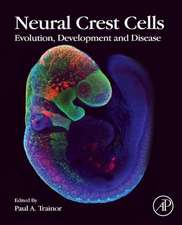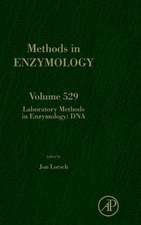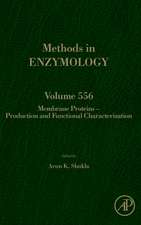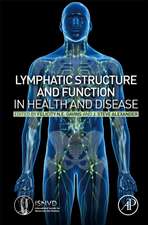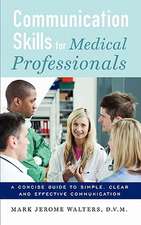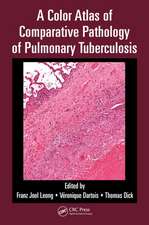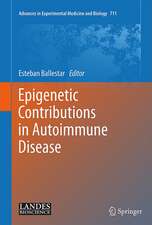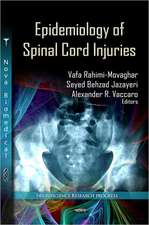Neural Repair and Regeneration after Spinal Cord Injury and Spine Trauma
Editat de Michael Fehlings, Brian Kwon, Alexander R. Vaccaro, F. Cumhur Oneren Limba Engleză Hardback – 21 feb 2022
These guidelines are quickly being adopted as the standard of care worldwide, and the comprehensive information found within this book will place these recommendations in context with current knowledge surrounding spinal cord injury and spine trauma.
- Contains contributions by international authors
- Covers recent clinical trial advancements and findings and updates on ongoing trials
- Presents an overview of clinical practice guidelines for the management of traumatic spinal cord injury featured
- Provides the reader with insights regarding the translation of research from bench to bedside and the skills needed to understand the translational pathway using real-life examples
Preț: 738.82 lei
Preț vechi: 890.42 lei
-17% Nou
141.37€ • 148.00$ • 116.98£
Carte tipărită la comandă
Livrare economică 01-15 aprilie
Specificații
ISBN-10: 0128198354
Pagini: 644
Ilustrații: Approx. 130 illustrations (130 in full color)
Dimensiuni: 191 x 235 mm
Editura: ELSEVIER SCIENCE
Public țintă
Clinical Spine Fellows; Residents; Neurosurgeons; Clinical and Basic Researchers; Orthopaedic Surgeons; Critical Care Specialists; Medical Students; Rehabilitation SpecialistsCuprins
1. Anatomy (touch on both spine trauma and SCI) 2. Epidemiology 3. Classification Systems: Spine Trauma 4. Classification Systems: SCI 5. Outcome Measures 6. Imaging: Spine Trauma 7. Imaging: SCI (include advanced imaging techniques) 8. Intraoperative imaging and Image Guidance 9. Spine Trauma Management Issues: Upper C-spine 10. Spine Trauma Management Issues: C-spine 11. Spine Trauma Management Issues: Thoracic and Lumbar 12. Spine Trauma Management Issues: Sacrum 13. Spine Trauma Management Issues: Polytrauma 14. Spine Trauma Management Issues: Geriatric 15. Spine Trauma- areas of controversy and emerging concepts 16. Traumatic Central Cord Injury 17. SCI Management: Pathophysiology 18. SCI Management: Role and Timing of Surgical Intervention 19. SCI Management: ICU Management (including MPSS) + Drugs 20. SCI Management: Rehabilitation 21. SCI Management: Economic Impact 22. Complications 23. Neurochemical Biomarkers of Acute Spinal Cord Injury 24. Clinical Trials: Drugs 25. Clinical Trials: Regenerative Approaches 26. Clinical Trials: Rehabilitation Approaches 27. Translational Perspective: Neuroprotective Strategies for Traumatic Spinal Cord Injury 28. Translational Perspective: Neuroregenerative Strategies for Traumatic Spinal Cord Injury 29. Emerging Concepts in the clinical management of SCI for the future 30. Translational Research in Spinal Cord Injury: What is in the Future?
Recenzii
Descriere
Neural Repair and Regeneration after Spinal Cord Injury and Spine Trauma provides readers with a comprehensive overview on the most up-to-date strategies to repair and regenerate the injured spinal cord following SCI and spine trauma. With contributions by international authors, chapters put regenerative approaches in context, allowing the reader to understand the challenges and future directions of regenerative therapies. Recent clinical trial advancements are thoroughly discussed, with the impact of trial findings addressed. Additionally, major ongoing clinical trials are included with thoughts from experts in the field. Recent clinical practice guidelines for the management of traumatic spinal cord injury are featured throughout.
These guidelines are quickly being adopted as the standard of care worldwide, and the comprehensive information found within this book will place these recommendations in context with current knowledge surrounding spinal cord injury and spine trauma.
- Contains contributions by international authors
- Covers recent clinical trial advancements and findings and updates on ongoing trials
- Presents an overview of clinical practice guidelines for the management of traumatic spinal cord injury featured
- Provides the reader with insights regarding the translation of research from bench to bedside and the skills needed to understand the translational pathway using real-life examples


